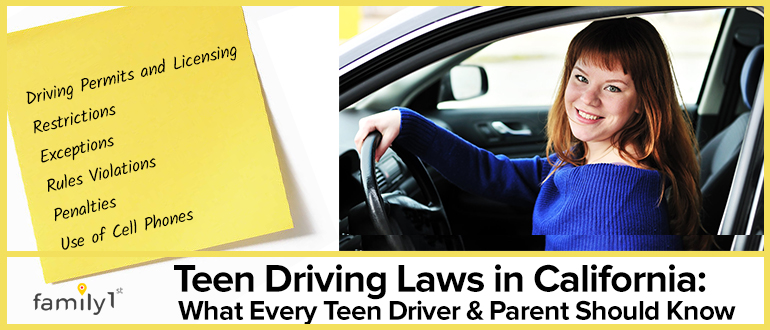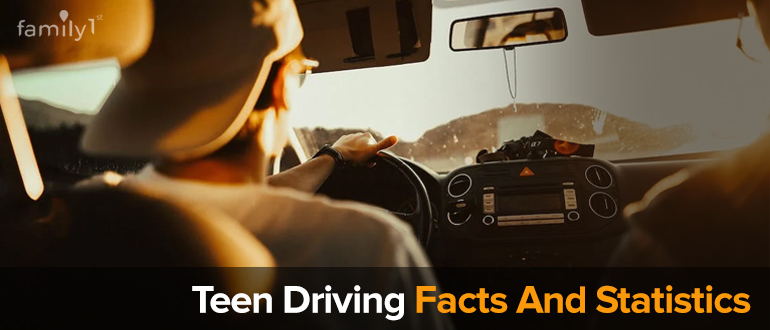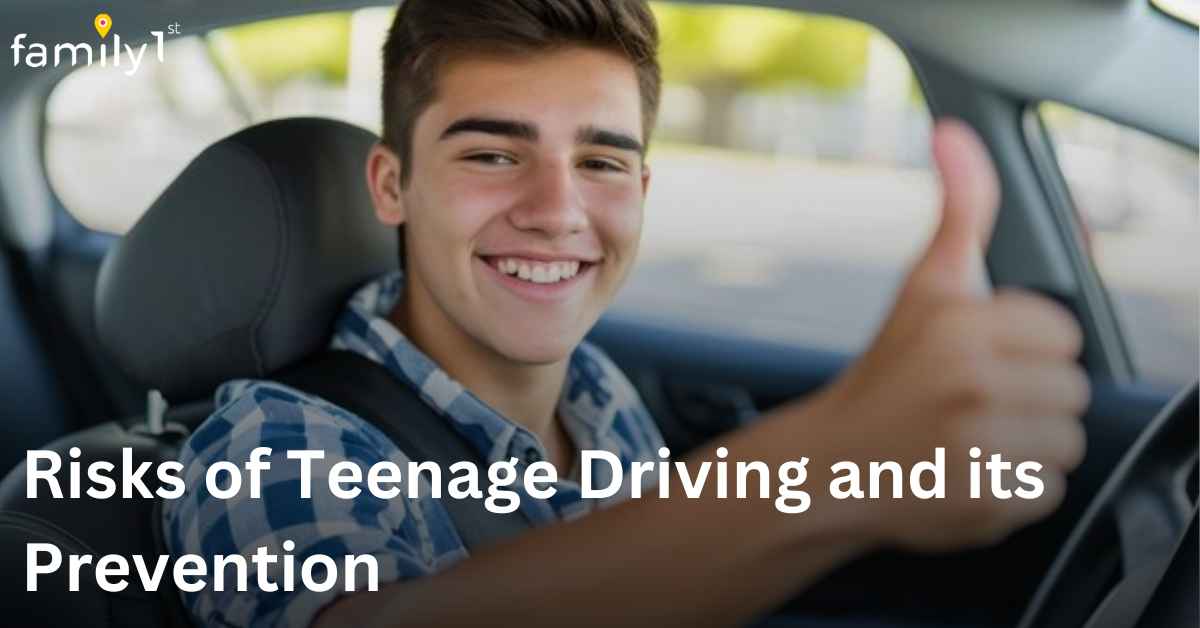When your teen starts to talk about having their car or driving yours, it is time to prepare them to learn. Familiarizing yourself with your state’s laws concerning teens and driving is wise. No matter what age your state allows, written permission is usually required for a teen under 18 to get a learner’s permit and then again to get a driver’s license. Parents can help teens become safe and defensive drivers by setting and enforcing ground rules. An important step is to analyze your teen’s maturity and emotional level and determine the correct age to start their initial driver training.
Table of Contents
California Teenage Driving Laws
California was one of the first states in the US to introduce a phased approach to full driving privileges for teens in the United States to reduce risks. Graduated Driver Licensing (GDL) is a research-based program as a countermeasure to address minor driver risk. GDL programs gradually introduce teens to the driving experience by phasing in full driving privileges over time and in lower-risk settings.
Motor vehicle crashes are a leading cause of teenage deaths in the U.S. Based on the most recent teen driver safety statistics released by the National Highway Traffic Safety Administration, 1,885 drivers (aged 15-20) died in traffic crashes in 2020, a 17% increase in driver fatalities from 1,616 in 2019. Of the young drivers killed, 52 percent were unrestrained and not wearing seat belts.
Year after year, crash statistics show that too many young drivers are at risk of being killed or injured on the roads. The high levels of crash risk experienced by young drivers – are a crucial element of the social and economic costs imposed on societies by road transport.
GDL programs are successful because they limit the risks to the teen while providing driving practice. Older teen drivers are missing out on the benefits of GDL programs. Those who begin licensing at 15-18 years have aged out of GDL.
GDL programs have different stages, identified by license type, provisions, and restrictions. Minor drivers must demonstrate responsible driving behavior during each licensing phase. New drivers progress from a learner license to a full permit over an extended period and at a pace suited to their individual needs.
Minor’s Provisional Driver’s License and Instruction Permit
A special provisional license and instruction permit is issued to minors to decrease motor-vehicle crashes.
Minor’s Permit Requirements
To get your minor’s instruction permit in California, you must be at least 15 1/2 years old but under 18 and complete an approved driver’s education course. You will need parents to sign the application and pass the traffic and road sign test as a prerequisite.
Exception: You can receive an instruction permit without finishing driving education or training if you are at least 17 ½ years old. To obtain a driver’s license, you must either wait until you are 18 or show documentation of your driving education and training completion.
Minors’ Permit Restrictions
Once that first lesson is complete, the driving instructor signs your permit, and you are now authorized to drive with an adult. Remember, you can only go with a parent, guardian, or an adult who is at least 25 years old and has a valid driver’s license. The accompanying adult needs to be able to take control of the car if a situation arises.
The Provisional Driver License Requirements
The provisional permit is invalid until you begin instructor-led behind-the-wheel driver training or become 16 years old and have held the instruction permit for at least six months. You must present proof of driver education and training completion. Your Parent/Guardian or instructor must verify completing 50 hours of driving practice (10 hours must be at night) and pass the driving test.
Check the licensing requirements inside that state or nation if you have a permit and intend to drive outside California.
The Provisional Driver License Restrictions
Minors may keep their driver’s license as long as they comply with the following rules:
- Obey the traffic laws and drive without a collision.
- During the first 12 months, a teen cannot drive between 11 p.m. and 5 a.m.
- A teen cannot transport passengers younger than 20.
However, Californian minor driving laws allow few exceptions: the teen driver can transport passengers younger than 20 years under the supervision of a California-licensed driver who is at least 25.
You can also drive past the curfew of 11 p.m. if there are some exceptions. You can go during the above if you are:
- Driving related to a medical emergency, with a note signed off by your physician.
- Going to or from an official school, for which a note must establish the school-authorized activity from the school principal.
- They are driving due to employment necessity with verifiable employment details.
- When running a quick errand after being asked by a parent or guardian,
- Emancipated Minor – Minors emancipated from their parents will be considered adults. When you enroll with DMV, you must affirm that you are an emancipated minor. Supporting documents include a California Insurance Proof Certificate, indicating that you are emancipated.
Primary law prohibits drivers under 18 from using a smartphone or other wireless electronic communication device while operating a motor vehicle. A hands-free device is permitted only for emergency services or on private land. In addition, local laws may restrict or prohibit driving during certain hours.
For comprehensive guidelines, please refer to the Department of Motor Vehicles (DMV) website at www.dmv.ca.gov for California Vehicle Code.
According to a report by the Centre for Disease Control and Prevention, teen driving casualties were such that about seven teens died every day in 209, followed by hundreds of teens injured in car accidents. We have curated a list of factors that cause accidents among teen drivers. Read here.
Penalties For Violating Teen Device Restrictions In California
A critical area of teen driver restriction is electronic communication. This is in place to reduce the risks associated with texting or talking on the phone while driving. Teens are also not permitted to use hands-free mode.
Teens who violate these restrictions will face an immediate 30-day license suspension if they receive two or more points in a calendar year. If a teen driver accumulates three or more points in any year, they face a six-month suspension and one-year probation, so ensure that you comply with all California teen driving laws. Community service, fines, and other penalties may be imposed.
Staying Involved
The phased approach set forward by California’s DMV to teach a teen to drive works best when a parent is actively involved. While California law establishes the prerequisites for teen driving, you, as a responsible parent and role model, can increase your child’s safety by ensuring that they obtain the necessary training.
California Department of Motor Vehicles (DMV) has urged parents to actively manage their teen’s driving experience by cooperating closely with them. The parent’s active involvement during the entire two-year teen driving procedure is discussed in the California Parent-Teen Training Guide. It begins with the kid receiving a learner’s permit and lasts for hours and months of practice driving under the supervision of parents. The time spent by the parent supervising, observing, and monitoring teen driving continues for the first six to twelve months after the child has a driver’s license.
Talk to your teen about obeying traffic laws and avoiding risky driving situations such as driving under the influence (DUI), high speeds, wearing seat belts, and traffic violations.
The California Department of Motor Vehicles (DMV) recommends a parent-teen driver agreement that serves as a type of template for outlining duties included in that manual. Detailed instructions are included in the contract, including who is responsible for car damage, maintenance and fuel, tickets, and other expenses. Teen drivers must understand their part in vehicle operation to ensure a safe journey.
The most critical part of the process is that teens log as many hours as possible with the parent in the passenger seat to supervise them. This will help mold a teen driver who has been violation-free for months after getting a license and has had their restrictions lifted gradually over time.
GPS Tracking For Teen Motorists
When teens get their licenses, parents no longer have to drive them all over town, and teens enjoy the freedom of moving around on their own. However, does the thought of your teen behind the wheel of a vehicle worry you? Now may be the time for you to step in and consider adding some money to the pot to the car-buying budget and invest in a GPS tracker. Installing a GPS on the car will allow you to monitor their driving remotely and alert you to any erratic behavior, such as excessive speeding or hard braking.
GPS-tracking devices are excellent monitoring mechanisms for bad driving behavior. Through these GPS tracker systems, parents can intervene and begin to shape positive driving behaviors if there is a cause for concern. Many car insurers offer discounts to families that utilize GPS-tracking devices because of their positive impact on driving behavior.
Family1st GPS is a real-time tracker to help parents keep their teen motorists safe. With Family1st GPS, you will never have to worry about where your teen is or if they are speeding while driving alone or with friends. GPS vehicle tracking can help parents stay in the know better with reports showing the locations a teen arrived at, departed from, and the time they were at each address.
Family1st GPS trackers enhance vehicle security. Depending on the subscription, the control center sends a message via text, email, or phone, alerting you of theft. Some auto insurance companies reward this enhancement of vehicle security by reducing rates. GPS tracking can help parents increase safe driving behaviors and potentially save insurance premiums.
The top Features of Family1st give you the tools that allow you to train your teen for better driving through:
- Accurate Time Speed Alerts To Your Cell Phone
- Daily driver’s report card and Historical Playback up to one year
- Long-lasting battery
- Real-time alerts
- Unlimited support and a lifetime warranty
- Water-resistant Design and Magnet case
- Works in the USA, Puerto Rico, Canada, and Mexico.
Raising teenagers can sometimes be a big challenge. But with the help of Family1st GPS tracking technology, parents can at least provide more peace of mind while ensuring teen driving safety and allowing them driving independence.











Next
Previous